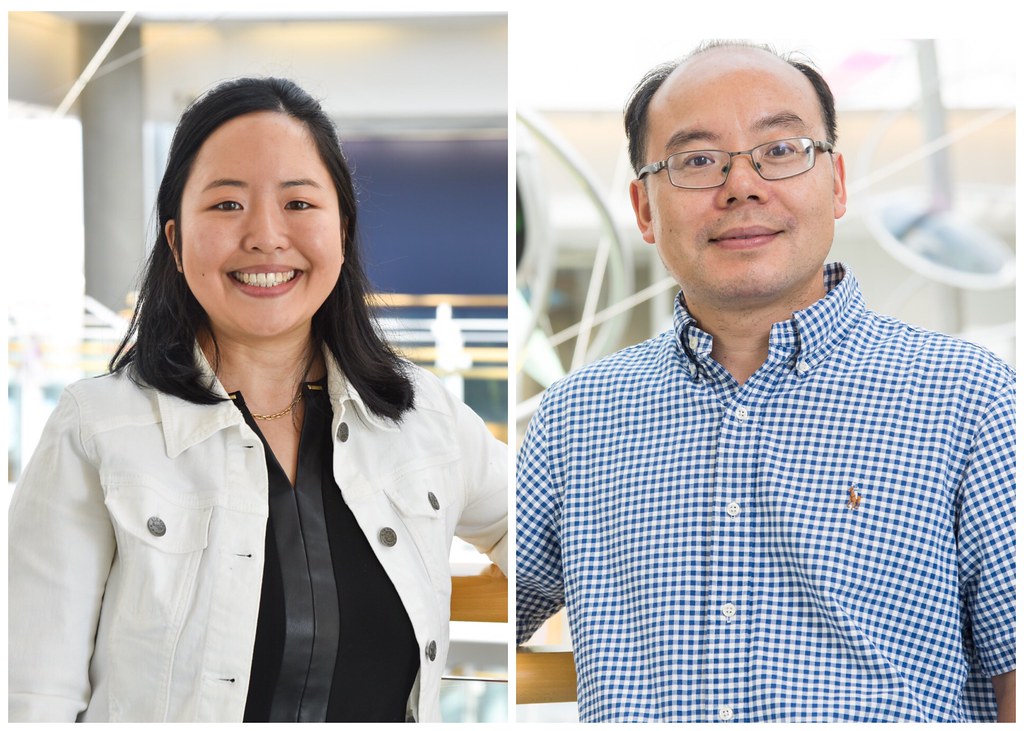News
Higher Viral Load May Lead to Less Severe Symptoms
Cynthia Tang and Henry Wan | photos by Becca Wolf and Roger Meissen, Bond LSC
By Becca Wolf | Bond LSC
You would think that the less sick you are, the less contagious you are. That’s just logic.
However, science isn’t always logical. Especially with Covid-19.
Henry Wan, principal investigator at Bond Life Sciences Center, recently found that when a person has mild symptoms of Covid-19 they have a higher amount of viral shedding.
He also found that people with a higher amount of virus on their positive swab test are less likely to be hospitalized than those with a lesser amount.
“We are really interested in whether this may be causing more or less hospitalizations, and we found the opposite in the analysis,” Wan said. “We found that viruses that mutate a certain way can make the disease less severe. We then wondered if there are any [particular] mutations that cause this.”
Wan and his lab decided to look at different Covid-19 mutations. Using positive Covid-19 tests from throughout Missouri, they found four local lineages and several mutations. With this information, they analyzed patient data to see how people are reacting to each mutation.
“We need to understand how the community gets the mutation and how it spreads,” Wan said. “We want to understand this very dynamic process in Missouri. We’ve seen a lot of mutations introduced in the past several months. Some of them continue to spread and some of them die. We want to know what ecology factors cause this.”
Cynthia Tang, a M.D. Ph.D. student in Wan’s lab, helped with the research. She did work on the data collection and performed the analysis.
“Within the first eight months in Missouri alone we identified four new lineages, which shows just how quickly the virus can mutate and spread,” Tang said. “We also found that viral load was increasing over time. That in itself was very interesting.”
They then looked at if the specific lineages were associated with the increase in viral load but did not find any conclusive evidence. As a result, they speculated that there may be an overall selective advantage towards more viral load and viral shedding, but then found that an increase in viral load was associated with decreased severity.
Given how novel Covid-19 is, they knew they had to expect anything. From the past experience on influenza pandemics and throughout pandemic outbreaks, viruses typically evolve to adapt to the human population, to be less severe while spreading more readily to become seasonal.
“It was challenging going into the research without a lot of information,” Tang said. “There are a lot of publications out there, but our overall foundation of this virus and the disease itself isn’t that strong yet since the pandemic just started, so it’s challenging trying to figure out what the right questions are.”
Wan used this as a teaching moment.
“In the past, we are taught about pandemics in a textbook and that they are far away from us — like the 1918 flu. But now, we’re in it,” Wan said. “This is a good opportunity to lead them through real situations. I’m sure when the students grow up and maybe become a professor or a scientist in the future, they will be ready to fight the next pandemic when it comes.”
As a student, Tang has learned a lot; she has never worked on a project quite like this.
“It’s been a really interesting experience because this is my first time working on something that has a pressing timeline,” Tang said. “We need to get answers quickly because it’s causing so much damage. You’re learning about it, and you’re discovering new things with everybody else.”
Wan and Tang are grateful for the learning experience and the findings of this research.
“This study gives us a better understanding of how the virus is adapting,” Tang said. “But I think it’s good news that the pathogenesis is decreasing for disease severity.”
As with much Covid-19 research, this work has been shared to help advance an understanding of the disease prior to peer review. You can read more about Wan and Tang’s work in the article, “Increased SAR-CoV-2 shedding associated with reduced disease severity despite continually emerging genetic variants,” in medRxiv.
